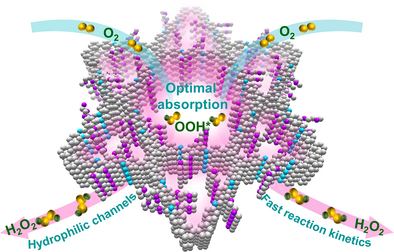Oligoether Chain Engineering in Covalent Organic Frameworks: Enhancing Transport Pathways and Oxygen Reduction Activity for Efficient Electrocatalytic Hydrogen Peroxide Production
Graphical Abstract
Oligoether chain engineering in covalent organic frameworks with hydrophilic ethylene oxide-based structures enhances mass diffusion and facilitates the formation of OOH* intermediate in the oxygen reduction reaction, leading to accelerated reaction kinetics and high selectivity for the two-electron pathway in hydrogen peroxide production.
Abstract
Oligoethers with various numbers of ethylene oxide (EO) units, known for their flexibility, electronegativity, and hydrophilicity, can be leveraged to construct complex molecular architectures with broad applicability. In this study, we present the synthesis of two-dimensional (2D) covalent organic frameworks (COFs) incorporating oligoethers with EO segments of varying lengths (2D-COF-EOs) to explore the role of EO units in modulating the two-electron (2e−) oxygen reduction reaction (ORR) pathway for electrocatalytic hydrogen peroxide (H2O2) production. By embedding hydrophilic EO side chains into the hydrophobic frameworks, intermolecular interactions are promoted through hydrogen bonding, leading to the self-assembly and spatial aggregation of these side chains. The high crystallinity of the COFs facilitates orderly stacking of the skeleton, creating hydrophilic nanoscale transport channels that enhance ORR kinetics. Among the synthesized COFs, 2D-COF-EO1, which contains one EO group, exhibits a remarkable H2O2 production rate of 5820 mmol gcat−1 h−1 and a 2e− ORR selectivity of 89.2%. Theoretical calculations and in situ electrocatalytic experiments reveal that the elongation of the EO units significantly alters the electronic structure of carbon atoms adjacent to oxygen atoms, lowering the energy barriers associated with the formation of OOH* intermediates and thus promoting the 2e− ORR pathway. This work offers valuable insights into optimizing COFs with different EO units for efficient 2e− ORR-based electrocatalytic processes.
Conflict of Interests
The authors declare no conflict of interest.
Open Research
Data Availability Statement
The data that support the findings of this study are available in the supplementary material of this article.





